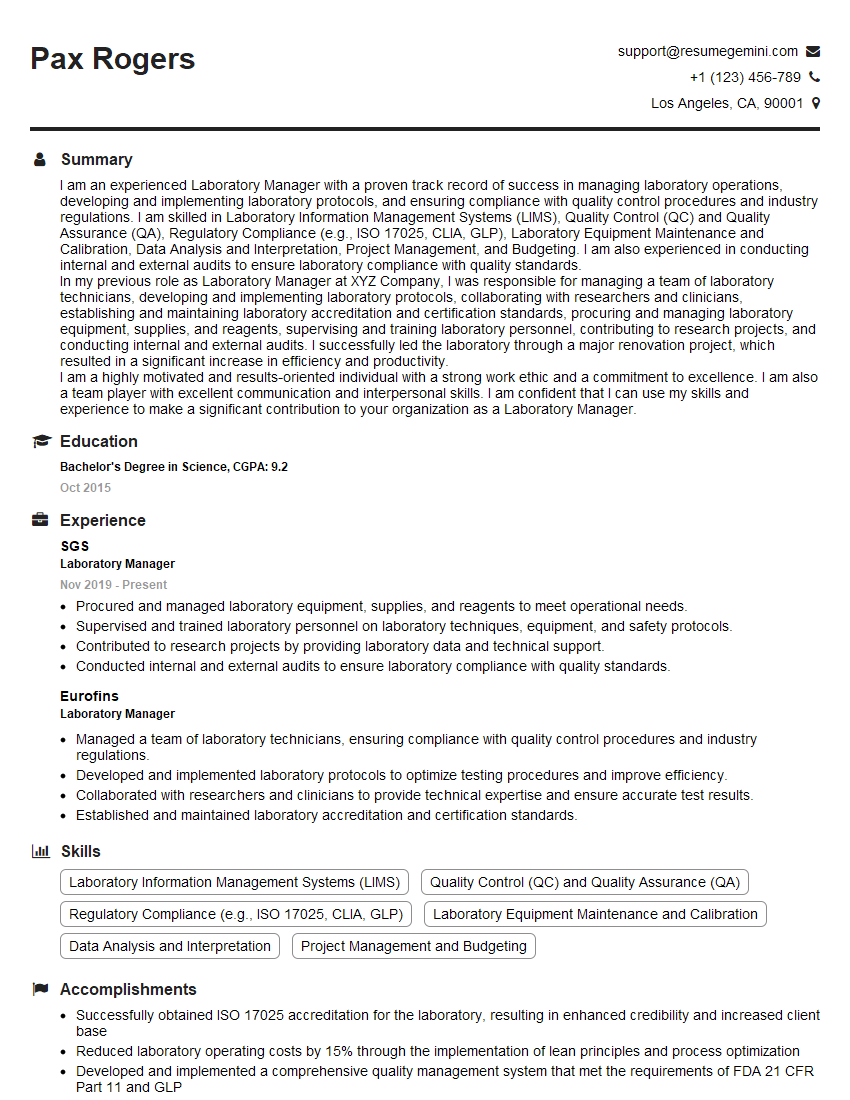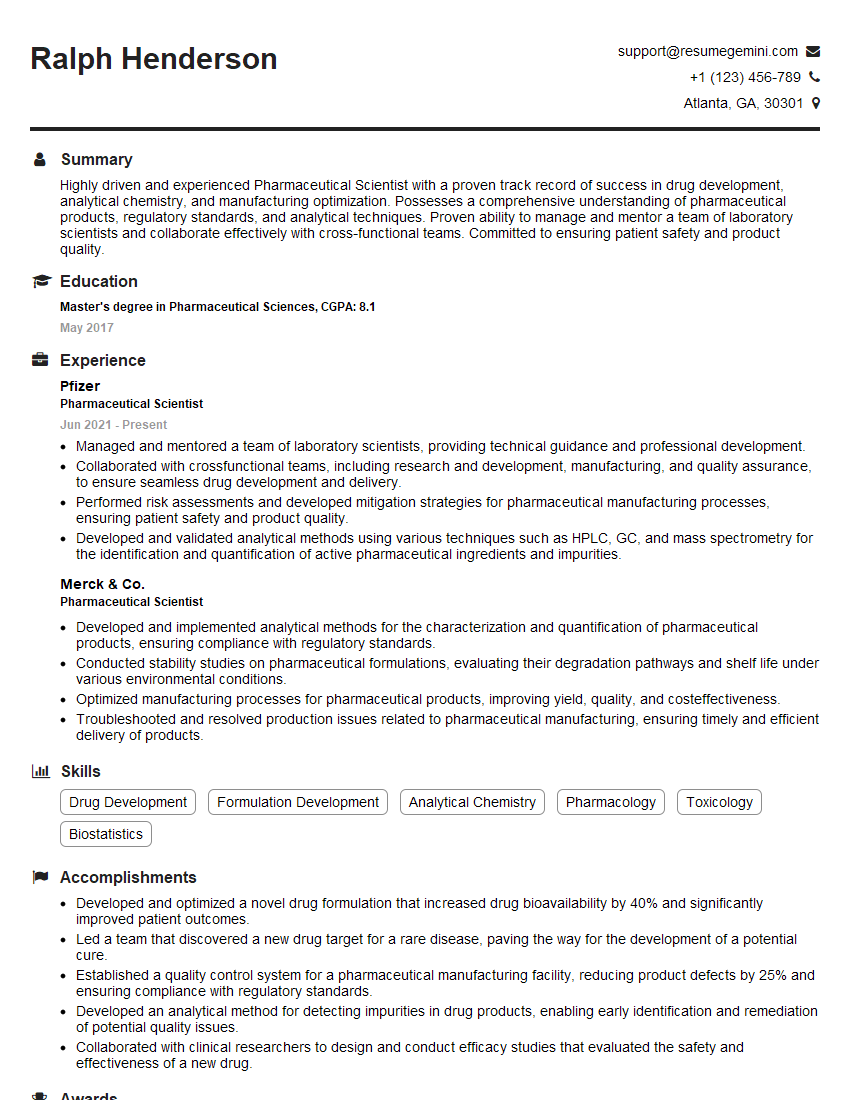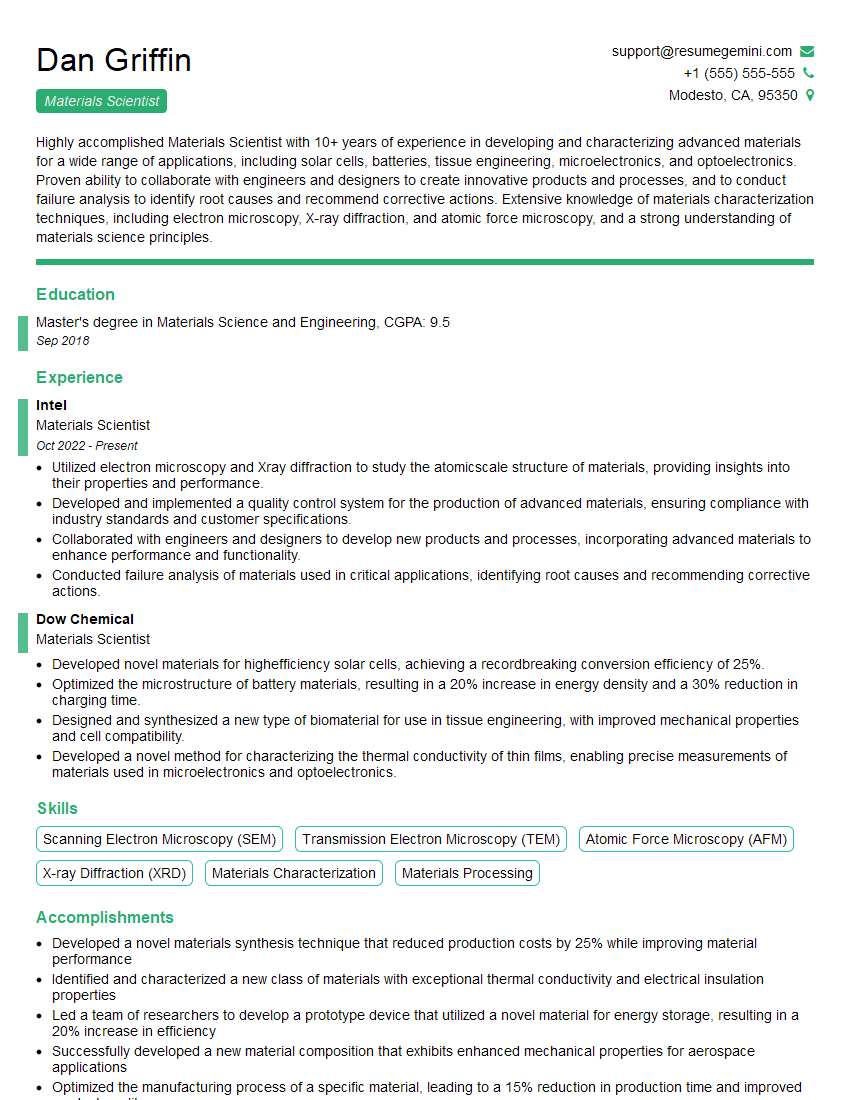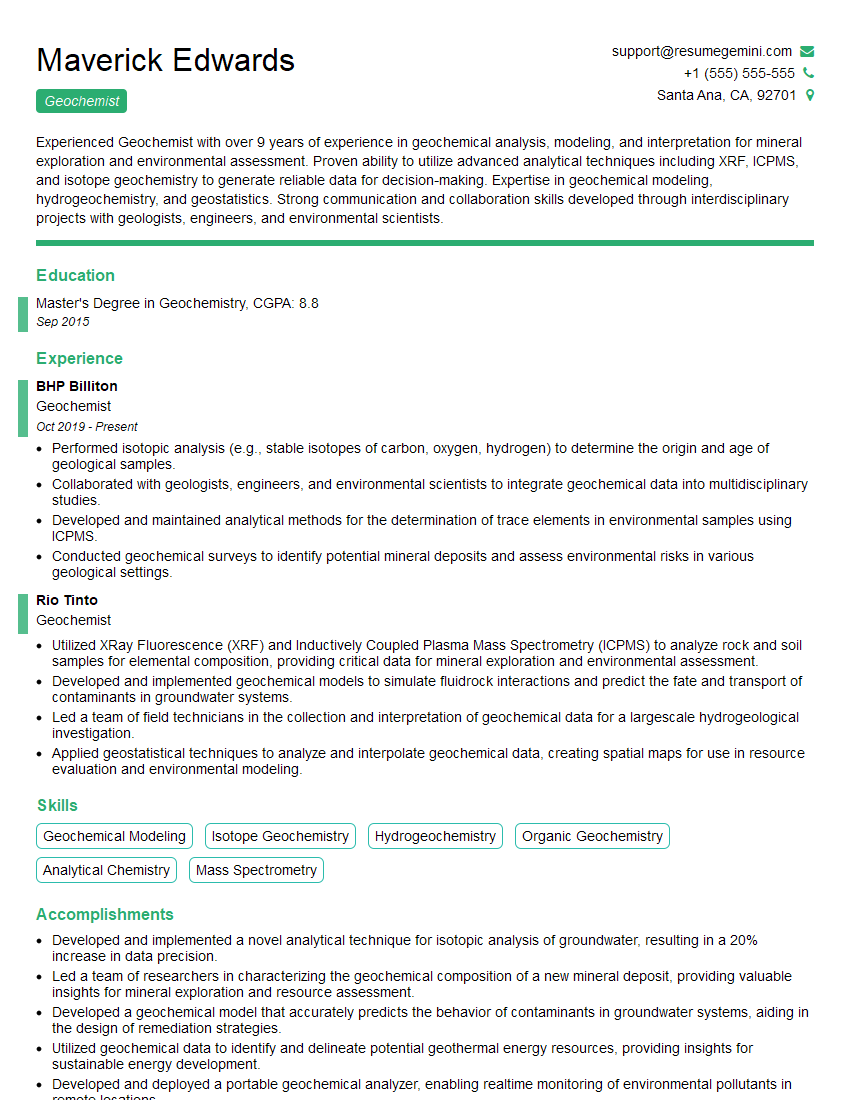Interviews are opportunities to demonstrate your expertise, and this guide is here to help you shine. Explore the essential Emission Spectroscopy interview questions that employers frequently ask, paired with strategies for crafting responses that set you apart from the competition.
Questions Asked in Emission Spectroscopy Interview
Q 1. Explain the principle of atomic emission spectroscopy.
Atomic emission spectroscopy (AES) is based on the fundamental principle that atoms, when excited by sufficient energy, will transition to higher energy levels. When these excited atoms return to their ground state, they emit light (photons) of specific wavelengths, characteristic of the element. Think of it like a firework: each element emits a unique color, which corresponds to a specific wavelength of light. This emitted light is then measured, and the intensity of the light at each wavelength is directly proportional to the concentration of the element in the sample. The unique ‘fingerprint’ of wavelengths allows for qualitative and quantitative analysis.
Q 2. Describe the different types of emission spectroscopy (e.g., AES, ICP-OES).
There are several types of emission spectroscopy, differing mainly in how the atoms are excited:
- Atomic Emission Spectroscopy (AES): This is the broadest term, encompassing various techniques. It typically uses a flame or electrical arc to excite the atoms. It’s relatively simple and inexpensive, but the sensitivity is generally lower compared to other methods.
- Inductively Coupled Plasma Optical Emission Spectrometry (ICP-OES): This is a powerful technique using an inductively coupled plasma (ICP) to excite the atoms. The ICP is a high-temperature plasma (around 7000 K) that provides efficient excitation of a wide range of elements, yielding superior sensitivity and lower detection limits compared to flame AES. It’s commonly used for environmental monitoring, food safety, and geological analysis.
- Inductively Coupled Plasma Mass Spectrometry (ICP-MS): While not strictly optical emission spectroscopy, it’s closely related. ICP-MS measures the mass-to-charge ratio of ions produced in the plasma, offering excellent sensitivity and isotopic information. It’s particularly useful for trace element analysis and isotopic ratio measurements.
Q 3. What are the advantages and disadvantages of using emission spectroscopy compared to other analytical techniques?
Emission spectroscopy offers several advantages:
- Multi-elemental analysis: It can simultaneously determine the concentration of multiple elements in a single sample, saving time and resources.
- High sensitivity: Particularly with ICP-OES, it achieves very low detection limits for many elements.
- Relatively simple sample preparation: Compared to some other techniques, sample preparation can be straightforward.
However, there are some disadvantages:
- Matrix effects: The presence of other elements in the sample can interfere with the analysis, requiring careful consideration of matrix matching or correction methods.
- Spectral interferences: Overlapping emission lines from different elements can complicate analysis, especially in complex samples.
- Cost: ICP-OES instruments are expensive, requiring significant investment.
Compared to techniques like Atomic Absorption Spectroscopy (AAS), emission spectroscopy, especially ICP-OES, generally offers higher sensitivity and multi-element capabilities, though AAS might be simpler and cheaper for single-element analysis.
Q 4. How does plasma excitation work in ICP-OES?
In ICP-OES, the plasma is generated by passing argon gas through a radio-frequency (RF) field. The RF field ionizes the argon gas, creating a highly energetic plasma. This plasma is sustained by the continuous flow of argon, and a high-temperature environment (approximately 7000K) is created. The sample, usually introduced as an aerosol, is then injected into the plasma. The intense heat of the plasma atomizes the sample and excites the constituent atoms, causing them to emit characteristic light.
Think of it like a miniature sun: the plasma is incredibly hot and efficiently excites atoms, leading to strong emission signals.
Q 5. Explain the role of the monochromator in emission spectroscopy.
The monochromator is a crucial component, responsible for separating the emitted light into its individual wavelengths. It acts like a prism, dispersing the light and allowing the detection of the intensity at specific wavelengths. This separation is essential because each element emits light at a unique set of wavelengths. By measuring the intensity of light at each wavelength, we can identify the elements present and quantify their concentrations.
Common types of monochromators include diffraction gratings, which use the diffraction of light to separate wavelengths.
Q 6. Describe the process of sample preparation for emission spectroscopy.
Sample preparation is critical for accurate results. The exact procedure depends on the sample type and the analyte of interest. Generally, it involves:
- Dissolution: Solid samples often need to be dissolved in a suitable solvent (e.g., acids) to create a solution that can be easily introduced into the instrument.
- Dilution: The resulting solution may need to be diluted to bring the analyte concentration within the instrument’s linear range.
- Filtration: Removing particulate matter to prevent clogging of the instrument’s nebulizer.
- Matrix matching: Preparing standards (calibration solutions) that closely match the matrix (composition) of the sample to minimize matrix effects.
For example, analyzing heavy metals in soil might involve digesting the soil sample with a mixture of nitric and hydrochloric acids before dilution and analysis by ICP-OES.
Q 7. How do you calibrate an emission spectrometer?
Calibration is essential for obtaining quantitative results. It involves measuring the emission intensity of a series of standard solutions containing known concentrations of the analyte. These standards are analyzed, and a calibration curve is constructed by plotting the emission intensity against the concentration. This curve is then used to determine the concentration of the analyte in unknown samples based on their measured emission intensity. Regular calibration checks are crucial to ensure accuracy and reliability, especially with long-term use of the instrument. External calibration (using separate standards) is commonly employed.
Q 8. What are the common interferences in emission spectroscopy and how can they be mitigated?
Interferences in emission spectroscopy are anything that affects the intensity of the emitted light besides the analyte’s concentration. They can significantly skew results, leading to inaccurate quantitative and qualitative analyses. Common interferences include:
- Spectral Interferences: These occur when the emission lines of different elements overlap. For instance, if you’re analyzing for sodium, the presence of potassium, which has emission lines close to sodium’s, can lead to overestimation of sodium concentration.
- Chemical Interferences: These involve reactions in the sample matrix that reduce the analyte’s ability to emit light. For example, the formation of stable compounds can prevent the analyte from being excited or ionized, thereby lowering emission intensity.
- Background Emission: This is a broad, continuous emission from the sample matrix, flame, or plasma. It can obscure weak analyte signals. Imagine trying to spot a tiny candle flame next to a bonfire; the background light makes it hard to see the smaller flame.
Mitigation strategies depend on the type of interference. Spectral interference can sometimes be addressed by using a different wavelength or a more selective method. Chemical interferences can be minimized by using releasing agents or buffers to alter the sample matrix, thereby preventing compound formation. Background emission is often subtracted using blank corrections or background correction techniques built into the instrument.
Q 9. Explain the concept of spectral resolution in emission spectroscopy.
Spectral resolution in emission spectroscopy refers to the instrument’s ability to distinguish between two closely spaced emission lines. A higher spectral resolution means the instrument can differentiate between wavelengths that are very close together. Think of it like the zoom function on a camera – higher resolution allows you to see finer details.
It’s crucial because emission lines can be very close. Poor resolution leads to overlapping lines, resulting in inaccurate measurements. The resolution is determined by the instrument’s design, the width of the entrance and exit slits, and the quality of the diffraction grating or prism used to separate the wavelengths. A high-resolution instrument is essential when analyzing complex samples with many elements or when elements have closely spaced lines.
Q 10. How do you identify elements using emission spectroscopy?
Element identification in emission spectroscopy relies on the unique emission spectrum of each element. Each element emits light at specific wavelengths when its atoms are excited. These wavelengths are like the element’s ‘fingerprint’. We measure the wavelengths of the emitted light and compare them to known spectral lines in databases. A match indicates the presence of a specific element.
The process is straightforward. After exciting the sample, the spectrometer measures the intensity of light at various wavelengths. The resulting spectrum displays peaks at wavelengths characteristic of the present elements. This is then compared against a reference spectral database like NIST Atomic Spectra Database. The presence of peaks at specific wavelengths confirms the presence of elements.
Q 11. How do you quantify the concentration of elements using emission spectroscopy?
Quantifying element concentration uses the intensity of the emitted light at a specific wavelength. The intensity is directly proportional to the concentration of the element; higher concentration equates to a stronger signal. However, it’s not a simple linear relationship; various factors like instrument settings and matrix effects need to be considered.
Often, a calibration curve is constructed by analyzing samples with known concentrations. We measure the emission intensity for each known concentration and plot it on a graph. The intensity of the unknown sample is then measured, and its concentration is determined by interpolation using the calibration curve. Internal standard methods can help compensate for variations in excitation and detection efficiencies.
Q 12. What are the limits of detection (LOD) and quantification (LOQ) in emission spectroscopy?
The limit of detection (LOD) is the lowest concentration of an analyte that can be reliably detected by the instrument. It’s usually defined as three times the standard deviation of the blank signal. The limit of quantification (LOQ) is the lowest concentration that can be reliably measured with acceptable accuracy and precision. It’s often set at 10 times the standard deviation of the blank signal.
Both LOD and LOQ are crucial for assessing the analytical capabilities of an instrument. A lower LOD and LOQ indicate better sensitivity; the instrument can detect and quantify smaller amounts of the analyte. These limits are affected by various factors, including background noise, instrument sensitivity, and sample matrix effects. In real-world scenarios, the LOD and LOQ determine the lowest concentration levels you can reliably analyze.
Q 13. Explain the difference between qualitative and quantitative analysis using emission spectroscopy.
Qualitative analysis in emission spectroscopy focuses on identifying which elements are present in a sample. It’s like answering the question ‘What is in this sample?’ We examine the spectrum to identify the emission lines and match them to known elemental spectra.
Quantitative analysis, on the other hand, determines the concentration or amount of each element in the sample. This answers ‘How much of each element is present?’ It requires a calibration curve and relates emission intensity to concentration. Qualitative analysis is a necessary precursor to quantitative analysis; you can only measure the concentration of an element you’ve identified.
Q 14. Describe the different types of detectors used in emission spectroscopy.
Various detectors are used in emission spectroscopy, each with its strengths and limitations. Common examples include:
- Photomultiplier Tubes (PMTs): These are highly sensitive detectors that convert light into an electrical signal. They are widely used for their excellent sensitivity and fast response times.
- Charge-Coupled Devices (CCDs): CCDs are array detectors that simultaneously measure light intensity over a range of wavelengths. They provide high sensitivity and allow for simultaneous detection of multiple elements. They are more expensive than PMTs but offer the advantage of parallel measurement.
- Photodiodes: These are simpler and less sensitive detectors than PMTs or CCDs, usually used for specific wavelength measurements. Their simplicity and lower cost make them suitable for applications needing less sensitivity
The choice of detector depends on the application’s specific requirements concerning sensitivity, wavelength range, and cost. For example, PMTs are often preferred for low-light applications requiring high sensitivity, whereas CCDs are better suited for applications requiring the simultaneous detection of multiple wavelengths.
Q 15. What are the safety precautions when operating an emission spectrometer?
Safety is paramount when operating an emission spectrometer. These instruments often involve high voltages, intense light sources, and potentially hazardous samples. Therefore, a multi-layered approach to safety is crucial.
- Eye Protection: Always wear appropriate safety glasses or goggles designed to protect against intense UV and visible light emitted by the instrument. Never look directly at the light source.
- Electrical Safety: Ensure the instrument is properly grounded and that all electrical connections are secure. Never work on the instrument while it’s powered on unless you’re a qualified technician.
- Sample Handling: Handle samples with care. Some samples might be corrosive, toxic, or flammable. Use appropriate personal protective equipment (PPE) like gloves, lab coats, and fume hoods when necessary. Follow proper waste disposal protocols for any hazardous materials.
- Emergency Procedures: Familiarize yourself with the location of emergency shut-off switches, eyewash stations, and fire extinguishers. Know the emergency procedures for your specific laboratory.
- Training: Only operate the instrument after receiving proper training. This includes understanding the instrument’s controls, safety features, and potential hazards.
For instance, I once witnessed a colleague accidentally expose themselves to intense UV light while aligning the spectrometer. Fortunately, they were wearing the proper eye protection, preventing serious injury. This highlights the importance of consistently following safety protocols.
Career Expert Tips:
- Ace those interviews! Prepare effectively by reviewing the Top 50 Most Common Interview Questions on ResumeGemini.
- Navigate your job search with confidence! Explore a wide range of Career Tips on ResumeGemini. Learn about common challenges and recommendations to overcome them.
- Craft the perfect resume! Master the Art of Resume Writing with ResumeGemini’s guide. Showcase your unique qualifications and achievements effectively.
- Don’t miss out on holiday savings! Build your dream resume with ResumeGemini’s ATS optimized templates.
Q 16. How do you perform routine maintenance on an emission spectrometer?
Routine maintenance is essential for the accuracy, precision, and longevity of an emission spectrometer. My typical routine involves several key steps:
- Optical Alignment: Regularly check and adjust the optical components, such as mirrors and gratings, to ensure optimal light path. This is often crucial for maintaining spectral resolution.
- Purge Gas Supply: For instruments utilizing purge gases (like argon) to minimize atmospheric interference, check the gas supply regularly and ensure it’s functioning correctly. Low gas pressure can severely affect signal quality.
- Detector Cleaning: Depending on the detector type (e.g., PMT, CCD), cleaning procedures vary. This might involve carefully cleaning the detector windows or replacing the detector if necessary. Contamination can lead to reduced sensitivity.
- Wavelength Calibration: Periodic wavelength calibration using certified standard samples is crucial to ensure accurate identification of elements. This is typically done with a known calibration lamp (e.g., Hg lamp).
- Software Updates: Keep the instrument’s control software up-to-date to benefit from bug fixes and new features that may improve performance.
- Record Keeping: Maintain a detailed log of all maintenance activities, including dates, performed actions, and any observations.
Imagine a scenario where the wavelength calibration drifts: the resulting spectral data would be inaccurate, potentially leading to wrong elemental analysis. Regular calibration avoids this common problem.
Q 17. Explain the concept of spectral line broadening in emission spectroscopy.
Spectral line broadening refers to the widening of spectral lines in emission spectroscopy, deviating from their ideal, infinitely narrow shape. This broadening obscures fine details and can affect the accuracy of quantitative analysis. Several factors contribute to this phenomenon:
- Doppler Broadening: The thermal motion of atoms in the sample causes a Doppler shift in the emitted light. Atoms moving towards the detector emit light at slightly higher frequencies, while those moving away emit at slightly lower frequencies, resulting in a broadened line.
- Pressure Broadening (Collisional Broadening): Interactions between atoms (collisions) perturb the energy levels and broaden the spectral lines. Higher pressure means more frequent collisions and wider lines.
- Natural Broadening: This is an inherent property of the excited state’s lifetime. The shorter the lifetime, the broader the spectral line due to the uncertainty principle.
- Instrumental Broadening: Limitations in the spectrometer’s optics, such as slit width and detector resolution, contribute to line broadening. A wider spectrometer slit will lead to increased instrumental broadening.
Consider the analysis of a metal alloy. If the spectral lines are significantly broadened due to high pressure in the sample’s plasma, it could become difficult to accurately quantify the concentration of different elements, affecting the quality control of the alloy’s composition.
Q 18. How do you troubleshoot common problems encountered in emission spectroscopy?
Troubleshooting in emission spectroscopy involves a systematic approach. I usually follow these steps:
- Check the obvious: Ensure the instrument is properly powered on, gas flow is adequate (if applicable), and the sample is correctly positioned.
- Examine the spectrum: Analyze the emission spectrum for any abnormalities. Weak signals might indicate a problem with the sample, detector sensitivity, or light path. Absence of expected lines could signify problems with the sample preparation or instrument calibration.
- Review calibration: Check for proper wavelength calibration using a standard lamp. If the calibration is off, recalibrate the instrument.
- Assess detector performance: Assess the detector’s response using a calibration standard. Low signal-to-noise ratio may suggest detector degradation or a problem with the light path.
- Investigate sample preparation: Inaccurate or incomplete sample preparation is a very common source of errors. Re-examine the sample preparation method for potential mistakes.
- Consult manuals and documentation: Refer to the instrument’s manuals and documentation for troubleshooting advice and error codes.
For example, I once encountered weak signals during analysis. After systematic checks, I found a slight misalignment in the optical system. Readjusting the mirrors solved the issue. This illustrates the importance of a structured approach to troubleshooting.
Q 19. What software packages are commonly used for data analysis in emission spectroscopy?
Several software packages are widely used for data analysis in emission spectroscopy. The choice often depends on the specific needs and the type of spectrometer used. Some common ones include:
- GRAMS/AI: A comprehensive suite of software for spectroscopy data analysis, offering features like peak identification, spectral fitting, and quantitative analysis.
- OriginPro: Another popular choice providing robust tools for data visualization, curve fitting, and statistical analysis. Its user-friendly interface makes it suitable for both novice and experienced users.
- SpectraGryph: Dedicated software with advanced features tailored to spectroscopic applications, including peak fitting and spectral library searching.
- Manufacturer-specific software: Many spectrometer manufacturers provide their own software packages optimized for their instruments. This software often offers direct control over the instrument and specialized analysis routines.
The software’s capabilities are crucial in extracting meaningful information from the raw spectral data. For example, using software to deconvolute overlapping peaks can improve the accuracy of quantitative analysis significantly.
Q 20. Describe your experience with data validation and quality control in emission spectroscopy.
Data validation and quality control are vital in emission spectroscopy to ensure the reliability and accuracy of results. My approach encompasses several key aspects:
- Blank corrections: Subtracting the blank signal (signal from the absence of the analyte) from the sample signal is crucial to correct for background interference.
- Internal standard method: Using an internal standard helps to compensate for variations in the sample introduction or excitation process, improving precision.
- Standard curves: Calibration curves prepared using certified reference materials (CRMs) are essential for quantitative analysis. The quality of these curves directly impacts the reliability of the results.
- Quality control samples: Regular analysis of QC samples (samples with known concentrations) interspersed with the samples of interest allows for ongoing monitoring of instrument performance and detection of potential drifts or errors.
- Statistical analysis: Evaluating the statistical parameters (e.g., limit of detection, limit of quantification, precision, accuracy) of the analytical methods is important for assessing the quality of the results.
- Documentation: Maintaining complete records of sample preparation, instrument parameters, and data analysis is vital for traceability and reproducibility.
In my previous work, we encountered a systematic bias in our measurements. By meticulously analyzing the quality control samples and reviewing the standard curves, we identified and corrected a small error in our sample preparation protocol, thereby improving the reliability of our findings.
Q 21. Explain how you would interpret an emission spectrum.
Interpreting an emission spectrum involves identifying and quantifying the elements present in the sample. The process typically involves these steps:
- Wavelength identification: Determine the wavelengths of the observed emission lines using the spectrometer’s calibration. Each element has a unique set of characteristic emission lines.
- Element identification: Compare the identified wavelengths to spectral databases or reference materials to identify the corresponding elements. Software packages significantly assist this step.
- Qualitative analysis: Determine which elements are present in the sample based on the presence of their characteristic emission lines.
- Quantitative analysis: Determine the concentration of each element. This often involves creating a calibration curve using standard samples with known concentrations of the analytes.
- Data interpretation and reporting: Interpret the results in the context of the sample and research questions. Write a comprehensive report detailing the methodology, results, and conclusions.
For instance, if I observe strong emission lines at 404.7 nm and 435.8 nm (among others), I would identify these lines as originating from mercury. The intensity of these lines, in conjunction with a calibration curve, would allow me to quantify the amount of mercury in the sample. This method allows us to analyze the composition of materials across various fields, from environmental monitoring to material science.
Q 22. Describe your experience with method validation and development in emission spectroscopy.
Method validation and development in emission spectroscopy are crucial for ensuring reliable and accurate results. My experience encompasses all stages, from initial method design to final validation report. This includes defining the method’s scope (analytes, matrix types, concentration range), developing the procedure (sample preparation, instrument parameters, calibration strategy), and meticulously validating its performance characteristics.
Specifically, I’ve extensively validated methods for determining trace metals in various matrices like water, soil, and biological samples using Inductively Coupled Plasma Optical Emission Spectrometry (ICP-OES) and Inductively Coupled Plasma Mass Spectrometry (ICP-MS). This involves assessing parameters like linearity, limit of detection (LOD), limit of quantification (LOQ), accuracy (recovery studies), precision (repeatability and reproducibility), and robustness (impact of minor changes in experimental conditions). I’m proficient in writing comprehensive validation reports that meet regulatory guidelines, such as those from the FDA or EPA.
For example, during a recent project analyzing heavy metals in wastewater, I developed and validated an ICP-OES method. We rigorously tested the method’s linearity across a wide concentration range, demonstrating excellent correlation (R² > 0.999). We also performed recovery studies using spiked samples to assess accuracy, achieving recoveries between 95-105% for all target analytes. This validated method is now routinely used in our laboratory for environmental monitoring.
Q 23. How would you handle a sample that is outside the calibration range?
Dealing with samples outside the calibration range requires a methodical approach to ensure accurate results. Simply extrapolating beyond the calibration curve is unreliable and can lead to significant errors. Instead, the preferred strategy is to dilute the sample to bring the analyte concentration within the calibrated range.
For example, if a sample yields a signal significantly higher than the highest point on the calibration curve, I would dilute the sample with a suitable blank matrix (e.g., deionized water for aqueous samples) by a known factor (e.g., 1:10 or 1:100 dilution). After dilution, the measurement is repeated, and the concentration is calculated by multiplying the measured concentration by the dilution factor. This ensures accuracy while remaining within the validated range of the calibration curve. In cases where even after significant dilution the signal is still too high, a new calibration curve that covers the higher concentration is constructed using standards over a broader concentration range.
Q 24. Discuss the impact of matrix effects on emission spectroscopy results.
Matrix effects are a significant concern in emission spectroscopy. The matrix refers to all components of the sample except the analyte of interest. These components can interfere with the excitation and emission processes, leading to inaccurate results. Interferences can be spectral (overlap of analyte and matrix emission lines) or non-spectral (changes in ionization efficiency, viscosity, or transport efficiency).
For instance, in ICP-OES, a high concentration of easily ionizable elements (like alkali metals) in the sample matrix can suppress the ionization of the analyte, leading to underestimation of its concentration. To mitigate these effects, various techniques are employed, including standard additions, internal standardization, and matrix matching. Standard additions involve adding known amounts of the analyte to the sample and plotting the response versus the added amount. Internal standardization uses an internal standard (a known concentration of an element not present in the sample) to correct for variations in the signal due to matrix effects. Matrix matching involves preparing calibration standards that closely mimic the sample’s composition, ensuring consistency and minimizing matrix effects.
Q 25. How do you ensure the accuracy and precision of your emission spectroscopy results?
Accuracy and precision are paramount in emission spectroscopy. Ensuring these qualities involves several key steps. Firstly, using certified reference materials (CRMs) is crucial. CRMs provide known concentrations of analytes in a specific matrix, enabling verification of method accuracy and quantification of systematic errors. Regular calibration checks with standards throughout the analytical run are necessary to correct for instrumental drift.
Precision is assessed through replicate measurements of both standards and samples. For example, analyzing a standard five times allows calculating the standard deviation, a measure of precision. Proper instrument maintenance and optimization also play a vital role. Regular cleaning of the nebulizer, torch, and other components prevents signal drift and contamination, improving both accuracy and precision. Furthermore, a well-documented quality control (QC) program, including the use of blanks and quality control samples (QCS) at regular intervals throughout the sample run, monitors the entire analytical process, flagging any potential issues.
Q 26. Describe your experience with different sample introduction techniques (e.g., pneumatic nebulization, electrothermal vaporization).
My experience encompasses various sample introduction techniques in emission spectroscopy, with expertise in both pneumatic nebulization and electrothermal vaporization. Pneumatic nebulization is a common technique in ICP-OES and ICP-MS, where a liquid sample is aspirated into a gas stream (argon) and converted into an aerosol for introduction into the plasma. This is relatively simple and robust, suitable for a wide range of sample types. However, it’s not ideal for highly viscous samples or those with a high dissolved solids content.
Electrothermal vaporization (ETV) is a more sophisticated technique, particularly useful for trace analysis. In ETV, a small volume of sample is placed in a graphite furnace, where it’s dried, ashed, and atomized via controlled heating. This process enhances sensitivity and reduces matrix interferences, making it advantageous for trace element determination in complex samples. I’ve utilized both techniques extensively, tailoring my approach based on the specific needs of the analysis – pneumatic nebulization for routine analysis of relatively simple samples and ETV for trace analysis in complex or limited sample volumes.
Q 27. How do you select the appropriate emission spectroscopy technique for a given analytical problem?
Selecting the appropriate emission spectroscopy technique depends on several factors, including the analyte’s concentration, the sample matrix, the required sensitivity and precision, and the available instrumentation. For example, Atomic Emission Spectrometry (AES) with a flame atomization source (flame-AES) is a cost-effective and simple technique suitable for determining relatively high concentrations of easily atomized elements in simple matrices. However, it’s less sensitive than other techniques.
ICP-OES offers higher sensitivity and is ideal for multi-element analysis in a wider range of matrices. ICP-MS provides even higher sensitivity, excellent isotopic information, and the ability to measure a wider range of elements, including non-metals. For trace analysis of difficult samples, techniques like Laser Induced Breakdown Spectroscopy (LIBS) or ETV-ICP-OES might be considered. Each technique has its strengths and limitations; careful consideration of the analytical requirements is crucial for optimal selection.
Q 28. Discuss the applications of emission spectroscopy in various fields (e.g., environmental monitoring, materials analysis, clinical chemistry).
Emission spectroscopy finds widespread applications across diverse fields. In environmental monitoring, it’s indispensable for determining trace metals in water, soil, and air, aiding in pollution control and environmental impact assessments. For example, ICP-OES is routinely used to monitor heavy metal contamination in rivers and lakes. In materials analysis, emission spectroscopy is used for compositional analysis of metals, alloys, and geological samples. It helps in quality control during manufacturing processes and in characterizing the properties of materials.
In clinical chemistry, emission spectroscopy techniques, particularly ICP-MS, play a crucial role in measuring trace elements in biological fluids (blood, urine), contributing to disease diagnosis and monitoring. For example, ICP-MS is used to measure essential and toxic trace metals in human samples. Other applications include food safety and quality control, where it’s employed to analyze trace elements in food products, ensuring they meet regulatory standards.
Key Topics to Learn for Emission Spectroscopy Interview
- Fundamental Principles: Understand the underlying physics of atomic emission, including excitation mechanisms (e.g., thermal, electrical, optical), relaxation processes, and the relationship between wavelength and energy.
- Instrumentation: Familiarize yourself with different types of emission spectrometers (e.g., atomic emission spectrometers (AES), inductively coupled plasma atomic emission spectroscopy (ICP-AES)), their components, and their operating principles. Be prepared to discuss the advantages and limitations of each.
- Spectral Line Identification and Analysis: Master the interpretation of emission spectra, including identifying elements based on their characteristic wavelengths, understanding spectral interferences, and applying quantitative analysis techniques.
- Sample Preparation and Handling: Know the importance of proper sample preparation for accurate and reliable results. Discuss various sample preparation techniques relevant to emission spectroscopy and their impact on analysis.
- Quantitative Analysis: Understand the methods used for quantitative analysis in emission spectroscopy, including calibration techniques (e.g., standard addition, internal standard), and the calculation of analyte concentrations.
- Applications in Various Fields: Be ready to discuss the applications of emission spectroscopy in different fields like environmental monitoring, materials science, food safety, and clinical diagnostics. Provide specific examples.
- Troubleshooting and Data Interpretation: Be prepared to discuss common challenges encountered in emission spectroscopy, such as spectral interferences, background correction, and data quality assessment. Practice interpreting spectral data and identifying potential sources of error.
- Safety Procedures: Understand and be able to discuss the safety precautions and regulations associated with operating emission spectroscopy equipment and handling samples.
Next Steps
Mastering Emission Spectroscopy opens doors to exciting career opportunities in analytical chemistry and related fields. A strong understanding of these principles is highly sought after by employers. To significantly improve your job prospects, it’s crucial to present your skills effectively. Creating an ATS-friendly resume is key. ResumeGemini is a trusted resource that can help you build a professional resume that highlights your expertise in Emission Spectroscopy. Examples of resumes tailored to this field are available to help guide your process.
Explore more articles
Users Rating of Our Blogs
Share Your Experience
We value your feedback! Please rate our content and share your thoughts (optional).
What Readers Say About Our Blog
Interesting Article, I liked the depth of knowledge you’ve shared.
Helpful, thanks for sharing.
Hi, I represent a social media marketing agency and liked your blog
Hi, I represent an SEO company that specialises in getting you AI citations and higher rankings on Google. I’d like to offer you a 100% free SEO audit for your website. Would you be interested?











